As the sun sets behind the horizon, a shimmering layer of Pixie dust settles across Disneyland. Torch-lit jungles underscored by the distant calls of unseen animals; wrought iron waterfronts alive with the smell of beignets and the sound of live jazz; frontier towns where lanterns signal refuge from the unknown of the uncharted wild West… Walt Disney would’ve been the first to admit: “a new kind of magic takes over in Disneyland after dark.”
That’s why we’ve launched a new limited series of in-depth stories that crisscross our Lost Legends, Modern Marvels, and Declassified Disaster collections: NIGHT MAGIC, the stories of the spectacles Imagineers have brought to life under cover of darkness at Disney Parks around the globe. Today, our Night Magic series continues to unfold with one of the most outrageous, extravagant, eccentric, hallucinatory, and downright wonder-full productions ever staged by Disney’s designers.
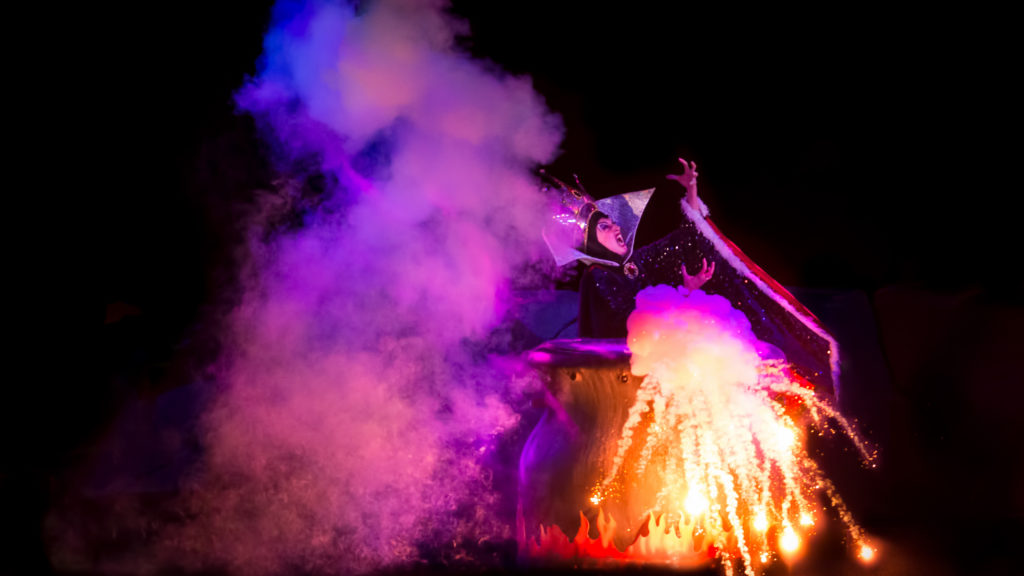
Each evening, Disneyland and Disney’s Hollywood Studios erupt into an abstract, larger-than-life, emotional, and epic battle between good and evil that’s loud, bright, and explosive enough to leave Las Vegas spectacles scrambling for more mortars. FANTASMIC! isn’t just a journey into Mickey’s imagination utilizing every tool in the Imagineering arsenal; it’s a generation-defining classic; a lasting testament to the grandeur of the “Ride the Movies” era; “the one to beat” for every nighttime spectacular to come after.
If you’re willing to grab a seat and settle in early, today we’ll take a journey through Disneyland history to discover the origins of the “natural” stage formed by the Rivers of America, the imaginative concepts dreamed up for its use, Imagineers’ incredible voyage through Mickey’s dreams, and how its one-of-a-kind “Magical Mix” makes this show an E-Ticket… Mysteries, magic, and visions fantastic await…
And before we head off, remember that you can unlock rare concept art and audio streams in this story, access over 100 Extra Features, and recieve an annual Membership card and postcard art set in the mail by supporting this clickbait-free, in-depth, ad-free theme park storytelling site for as little as $2 / month! Become a Park Lore Member to join the story! Until then, let’s start at the beginning…
The Big River
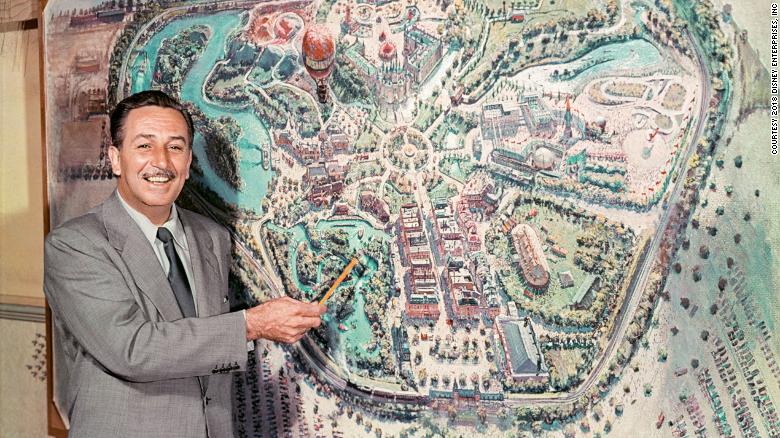
Though we often tend to take it for granted today, once in a while we run into a story that reminds us of just how innovative Disneyland was. We have to remember, after all, that nothing like it – no master-planned “theme park” at all – had been built. To that end, Walt’s designers weren’t just inventing or applying the fanciful and trivia-friendly concepts we love to discuss – like the hub-and-spokes layout, forced perspective, or ticket books – they were also facing real, logistical and operational hurdles in making Disneyland work.
One of the most compelling engineering successes in the park’s early history must be a “natural” feature Disneyland guests probably never even question: the Rivers of America. The idea of a winding waterway encircling an island wasn’t just present from the very first plans for Disneyland; it predates them!

In fact, a Mississippi steamboat paddling its way around an island was one of the many concepts developed and drawn up as early as 1951 for “Mickey Mouse Park” – an early leisure park and visitor experience concept initially envisioned for a vacant lot adjacent to the Disney Studios in Burbank.
When the idea finally came to fruition as Disneyland’s Rivers of America, it presented a unique engineering challenge. One of the park’s first infrastructural hurdles was how to keep Disneyland’s not-so-natural waterways from stagnating into mosquito-ridden pools of still, mossy water. So even though most guests probably never even consider it, behind the scenes, Disneyland’s engineers devised a way to keep the park’s waterways circulating through a cleverly-interconnected “Big River” system.
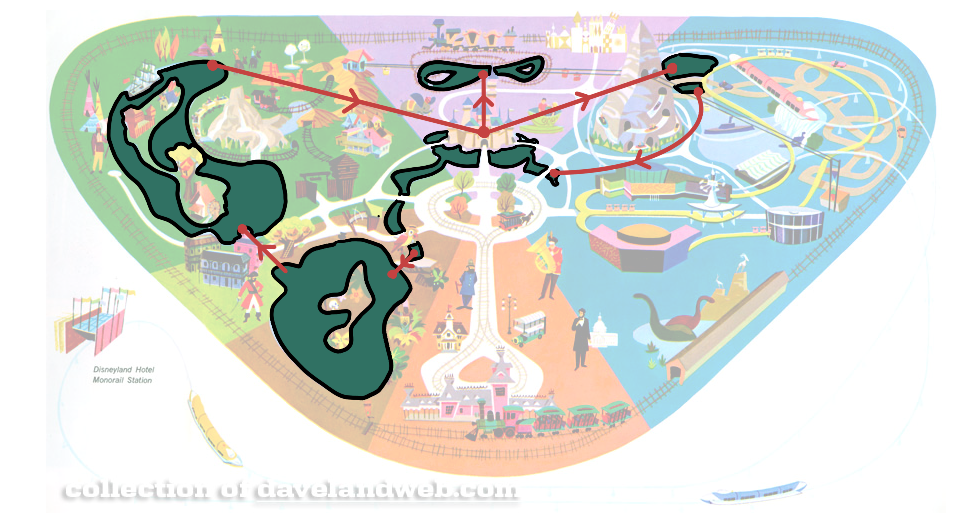
As told by Sam Gennaway, Disneyland’s “Big River” begins at the system’s lowest point: the Rivers of America. There, at the northernmost bend in the waterway, the park’s dyed “dark water” is captured by a drain and pumped via 25-horsepower motor through a two-foot-wide pipe up a gradual incline to an elevation fifteen feet higher under Sleeping Beauty Castle.
From there, pipes diverge. One carries water to the park’s Storybook Land Canal Boats. A second funnels into the (now vacant) Motorboat Cruise lagoon. From there, another segment carries “dark water” around the current site of the Matterhorn to Snow White’s Grotto, where a waterfall feeds into the Sleeping Beauty Castle moat. Water then floats through the moat, under the bridges to Frontierland and Adventureland, and through the Jungle Cruise until bubbling up into a spring beneath the Treehouse. Then, it finally returns to its lowest elevation back in the Rivers of America. Now that’s a Journey of Water!
As for what would go in the water…
Fowler’s Harbor
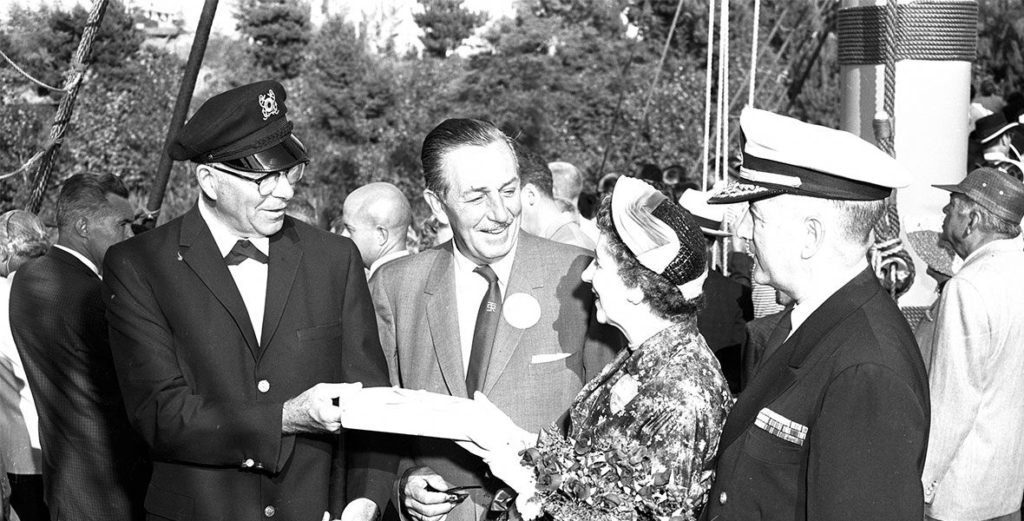
Walt’s early dreams of a Mississippi steamboat churning through the waters of Disneyland might’ve seen like an indulgent fantasy… but with Admiral Joe Fowler, anything was possible. A Naval Academy and MIT Design graduate, Fowler had a way of meeting Walt’s curiosity and enthusiasm.
As evidence, Disney Legend Bob Matheison recalled a day when Walt had Fowler consult about a stage show at Adventureland’s Tahitian Terrace: “Walt turned to Joe and said, ‘I’d like to part the water and let the entertainers come out, and then have the waterfall close behind them.’ Joe never batted an eye. He just said, ‘Can do, can do.’ I know he had no idea how he was going to part the water, but he said it without hesitation — ’Can do.’ And by golly, he did it.”
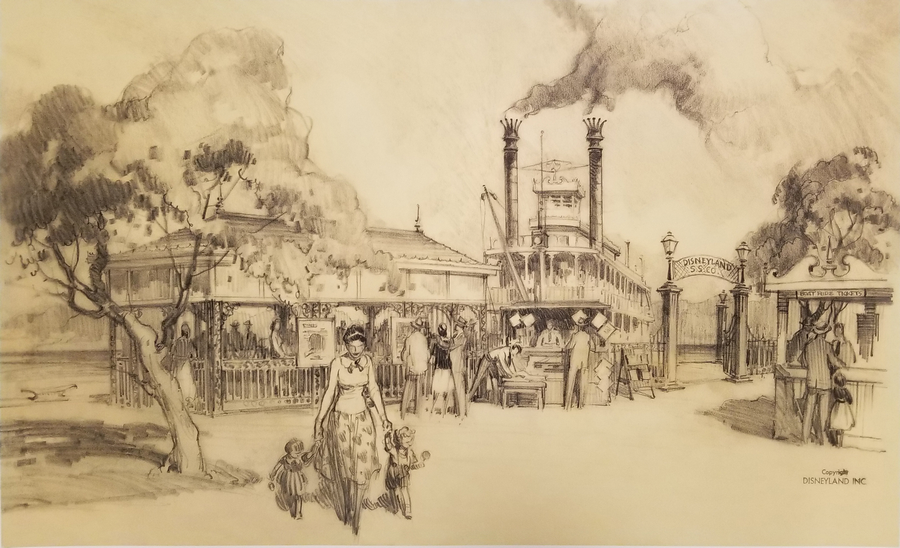
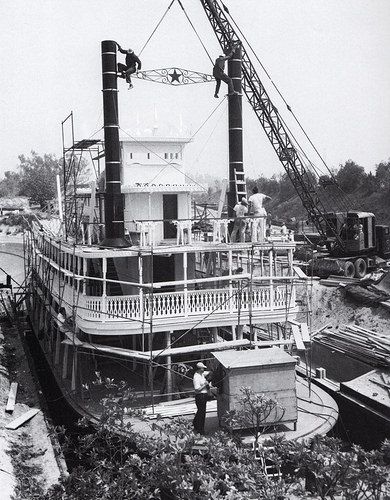
So for Fowler, resurrecting the long-lost art of building genuine, steam-powered paddle-wheelers was just another day in the office. In fact, the Mark Twain was the first steamship built in the United States in more than fifty years.
Thanks to his Naval service, Fowler recognized that it was essential for the Rivers of America to contain a dry dock so that the Mark Twain could be serviced and repaired. Walt was reportedly incensed at the massive piece of real estate taken up by the “wasteful” endeavor and took to calling it “Joe’s Ditch.” (It remains today, with the much more respectful designation “Fowler’s Harbor.” In his honor, Walt Disney World’s Magic Kingdom would later name one of its own River sternwheelers the Admiral Joe Fowler. Today, it’s the name of one of the ferries that traverse the Seven Seas Lagoon.)
Regardless, the ship was so important to Walt that it took its maiden voyage four days before the park’s opening – July 13, 1955 – with a private party on board to celebrate Walt and Lillian’s 30th wedding anniversary.
Unfortunately, for all their engineering prowess, Disneyland’s initial crew missed one detail. During the park’s construction, workers filled the 6 million gallon Rivers of America only to return the next day and find it dry. Anaheim’s sandy substrate had soaked up almost every gallon. Talk about “learning as you go.”
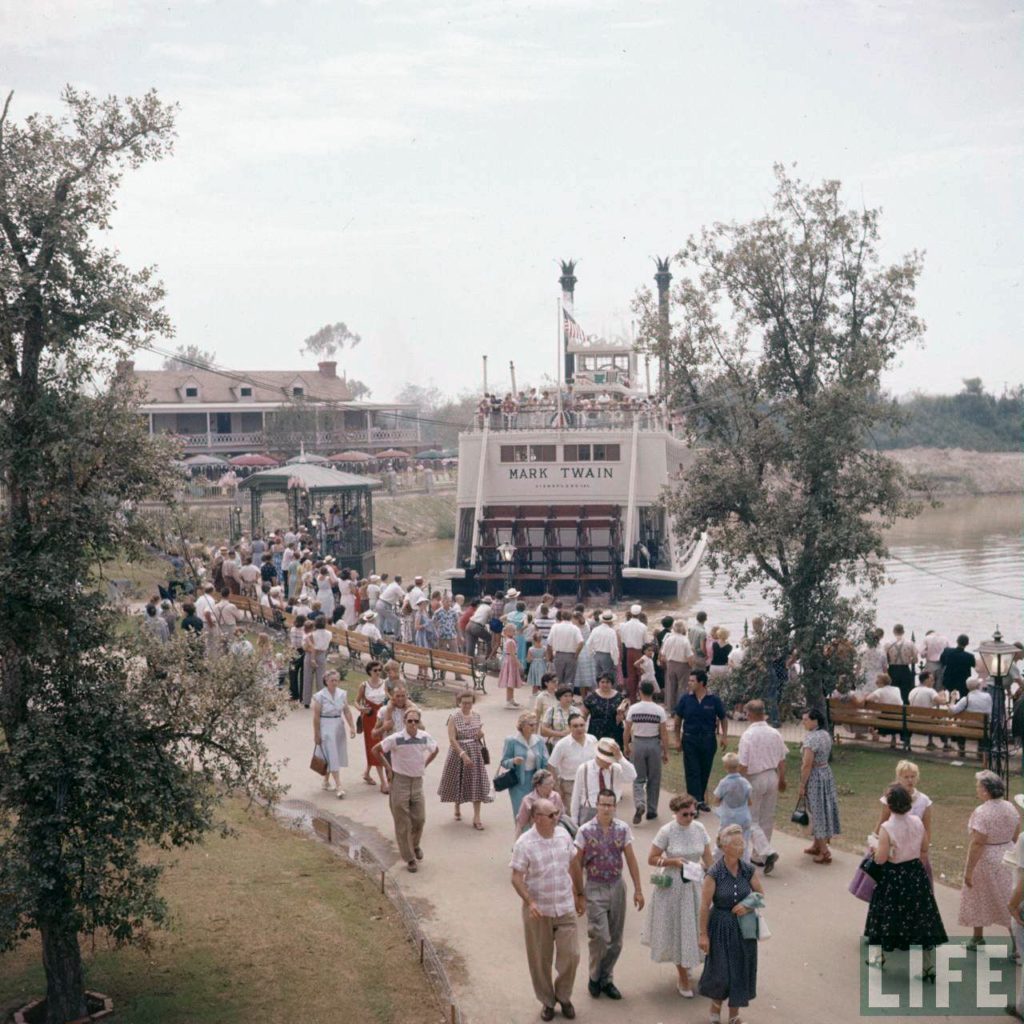
Disneyland opened on July 17, 1955. The good news is, the Rivers of America were ready for business… even if they were a little brown. That’s because crews had needed to coat the entirety of the riverbed in hundreds of trucks’ worth of hard clay to prevent another drainage issue. (It’s for the best – the clay color helped disguise that the water is only four feet deep, and with a track keeping the Mark Twain on its circuit.)
Still, the Opening Day original toured guests along the remote wilderness northwest of the park, passing Frontierland’s Indian Village, a burning cabin, and mechanical “wildlife” set back from the water’s edge. Six months after the park opened, the Mark Twain was joined by the Mike Fink Keelboats plowing their way through the waters of Frontierland. The next year, Indian War Canoes began to depart from the Indian Village, nimbly darting around the river’s larger vessels in a guest-powered trip through the wilderness.
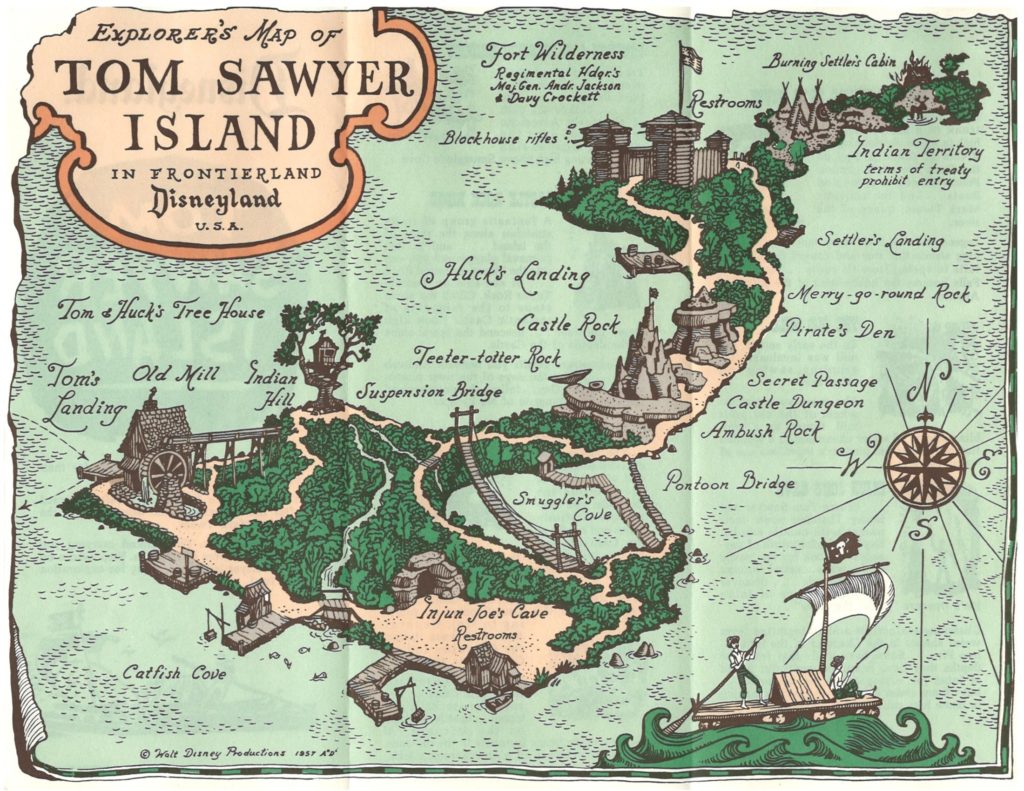
Just before the park’s first anniversary, in June 1956, Rafts to Tom Sawyer Island joined the river race, ferrying guests to and from the brand new explorer’s island (famously, the only part of the park to be conceptually plotted and mapped by Walt himself).
Within that first year, Walt requested that Fowler select a second ship to join the Mark Twain, and after scouring maritime museums, Fowler picked the Columbia Redivivia – the first American ship to circumnavigate the globe.
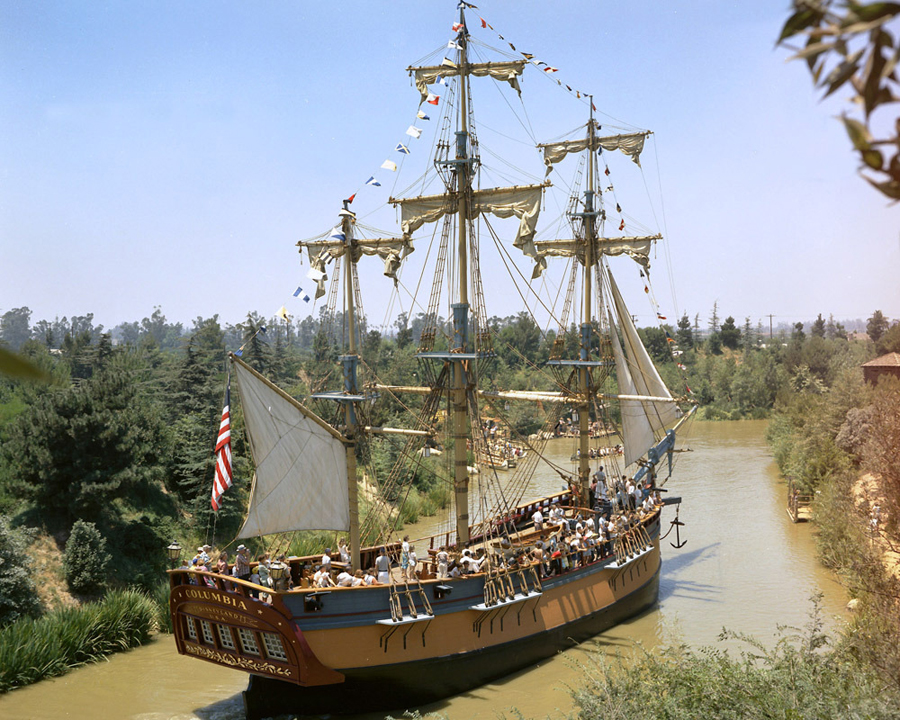
Working off of a single photograph of the ship, Imagineers designed their own full-scale recreation of the Columbia, which joined the River traffic In 1958.
So by the park’s third anniversary, Frontierland’s waterway had well and truly come alive. Disneyland’s Rivers of America was home to wooden rafts, darting canoes, cutting keelboats, and two stunning riverboats – The Mark Twain and the Columbia – together representing the era of American expansion, the wonders of taming the wilderness, and the joy and freedom of Western exploration.
And here’s where our story really picks up. Walt and his designers had successfully created a river. Now, they needed to use it.
Dixieland at Disneyland
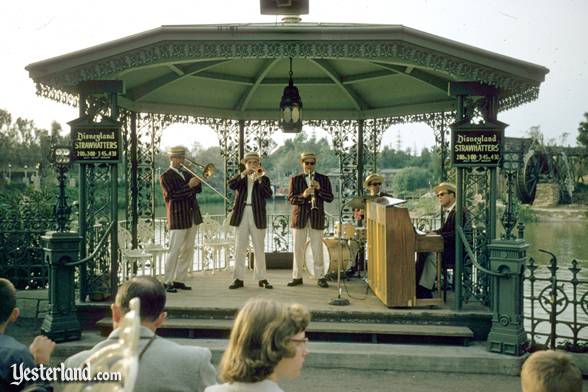
Right at the crux of the Rivers of America’s southern bend – standing between the settled Frontierland and the wild expanse leading to the remote Nature’s Wonderland – stood the Frontierland Bandstand. Beginning shortly after the park opened, it became a centralized stage for the music Walt loved: jazz and Dixieland.
In particular, a performance group called The Strawhatters (above, via Yesterland) became such an icon on the Bandstand that guests were known to flock to Tom Sawyer Island or time their Mark Twain rides so as to sail past the Bandstand in time to catch the show! Disneyland – ever the locals’ park – had found a new act to keep guests dancing into the night. Suffice it to say that Walt was always someone who went with his gut, and sensing that he’d stumbled on an opportunity, he decided to make it official.
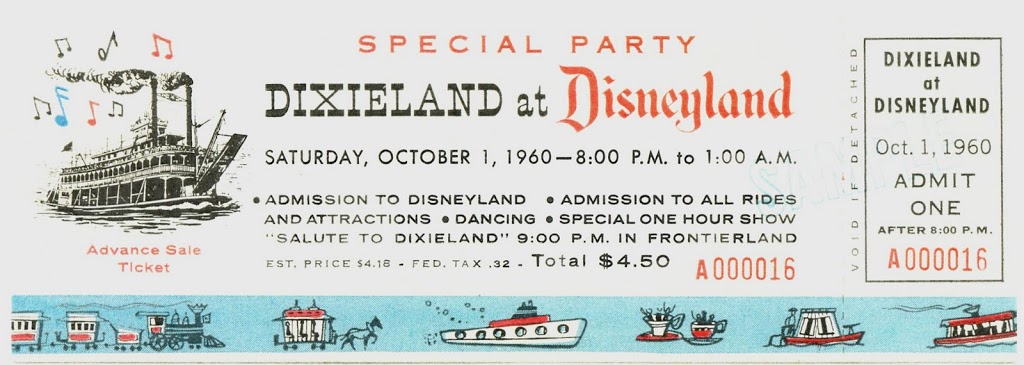
In 1960, the park hosted its first annual Dixieland at Disneyland special event. The Rivers of America sprung to life with Mardi Gras floats, jazz bands sailing the river on rafts, multi-colored spotlights, and celebratory fireworks over the island. The night’s grand finale saw all of the featured bands climb aboard the Mark Twain together for a final performance of a Dixieland favorite – “When the Saints Go Marching In” – as guests on the banks waved sparklers and created a live music procession through the park, playing until 1 AM.
Dixieland at Disneyland became an annual tradition, drawing folks from across the region. In 1962, the legendary Louis “Sachmo” Armstrong even performed live aboard the Mark Twain himself, as chronicled in 1962 “Disneyland After Dark” episode of The Wonderful World of Color.
Between performances, he suggested they ought to “rock this ole Mark Twain right on down to New Orleans.” He couldn’t have known how right he was.
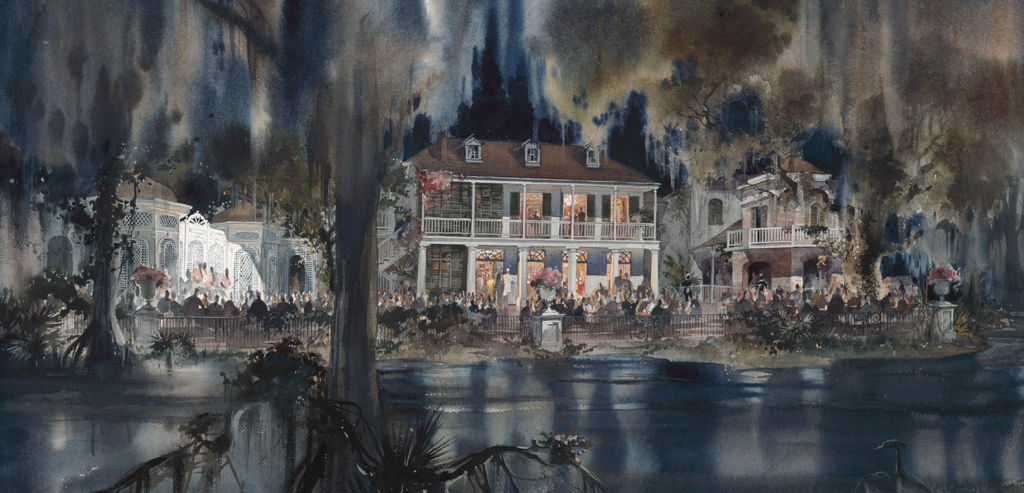
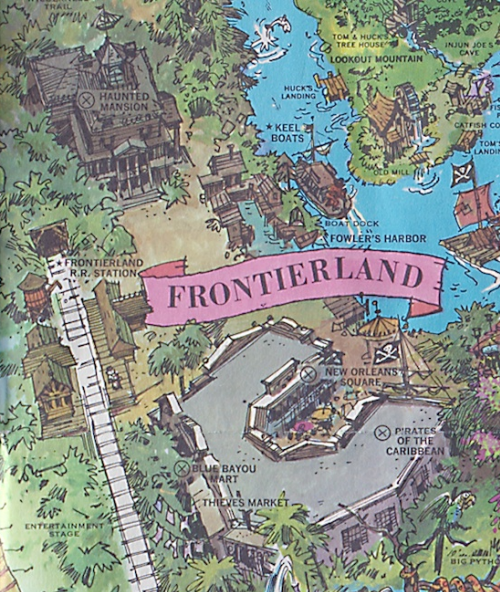
By 1958, souvenir maps of the park were already showing Walt’s next project: an expansion of Frontierland that would carve out a whole area dedicated to New Orleans – and with two new attractions, at that. Construction began in earnest in 1961, and by time it readied for opening in 1966, New Orleans Square had been promoted to full standalone “land” status, advertised as the first new land added to the park since its opening.
It’s really no surprise that New Orleans Square is often regarded as one of the best Disney Parks lands on Earth and a beloved Disneyland exclusive. Quintessentially Walt and perfectly scaled for storybook Disneyland, the little land ultimately emerged as a new peak of Imagineering; a waterfront paradise of hot beignets, wrought iron patios, crawling ivy and Spanish moss, gas lamps, bauble shops, hidden alleys, sweeping staircases, secret apartments and concealed jazz clubs, mint juleps and magnolia trees, and live brass bands every night. Oh, and, of course, two of the most legendary attractions ever made: Pirates of the Caribbean and the Haunted Mansion.
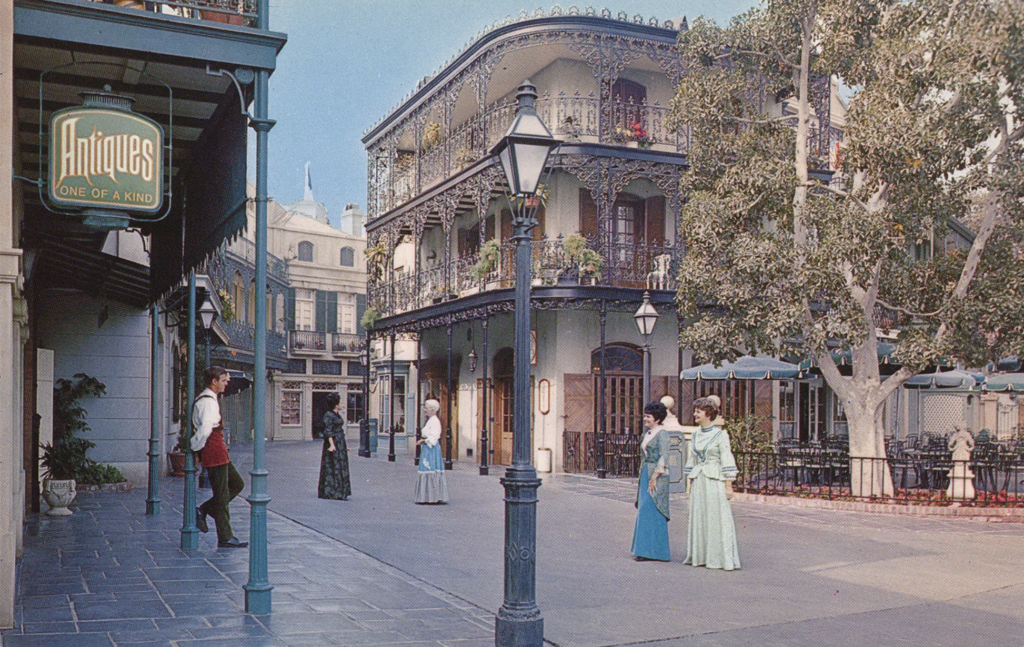
Unfortunately, the official dedication of New Orleans Square was the last public appearance Walt ever made at the park. He died of lung cancer in December 1966 – just six months before Pirates would open.
Now, we’ve filled the river. We’ve built the stage. We’ve created a land that comes alive at sunset. And on the next page, we’ll introduce the minds behind Fantasmic! and the shows we almost got in its place… Read on…


